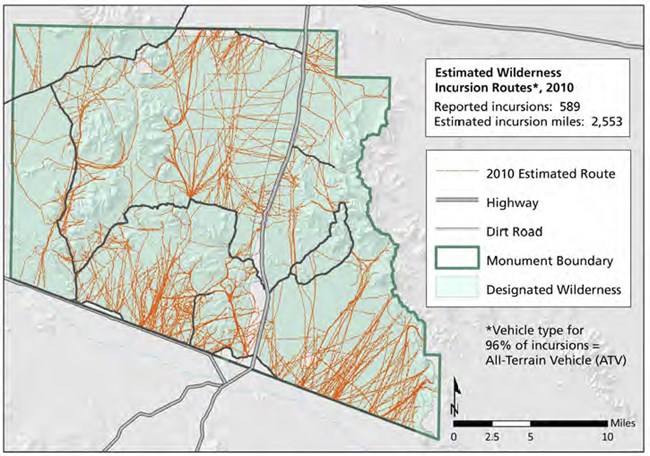
Overview
Size: 133,882 hectares
Elevation range: 305–1,463 meters
Organ Pipe Cactus National Monument, in southwestern Arizona, was established by presidential proclamation in 1937 to preserve approximately 330,000 acres of the Sonoran Desert for the public interest.
The monument is a refuge for plants and animals that have adapted to the region's extreme temperatures, intense sunlight, and sparse rainfall. Twenty-six species of cactus live in the monument, including the park's namesake organ pipe cactus and the giant saguaro.
Located in the Sonoran Desert ecoregion, the monument is part of four biomes: desert, thornscrub, semi-desert grassland, and Madrean evergreen woodland. Average annual precipitation is 9.6 inches (245 mm).
The Sonoran Desert Network monitors air quality, climate, groundwater, landbirds, springs, seeps, and tinajas, and vegetation and soils at Organ Pipe Cactus National Monument. The results of this work can be found in a variety of publications and other information. The network also maintains species lists for the park.
Key Issues
Natural resource concerns at the park include border-related impacts (including thousands of miles of unauthorized roads and trails, associated damage to soils and vegetation, interruption of natural ecological processes, disturbance to wildlife movements, an abundance of trash, and impacts to surface hydrology related to the pedestrian fence); highway impacts to wildlife and adjacent habitats; human-caused fire; invasive exotic plants; a lack of knowledge about visitor use; and adjacent land-use trends.

Undesignated roads and trails
As of 2010, there were an estimated 2,553 miles of undesignated roads and trails through the wilderness of Organ Pipe Cactus National Monument. These incursions damage soils, vegetation, and wildlife habitat. Park managers are working to understand the extent and nature of these impacts, and are collecting baseline data on un-impacted areas to facilitate ongoing and long-range restoration plans.
Pedestrian Fence
In spring 2008, the U.S. Department of Homeland Security constructed a five-mile section of pedestrian barrier fence along Organ Pipe Cactus National Monument's south boundary, adjacent to the U.S./Mexico border.
Due to concerns that the fence, made of steel mesh and grate, could disrupt overland water and debris flow at wash crossings during flood events, six permanent monitoring sites measuring cross-section elevation were installed at major wash channels along the fence in April 2008. Four cross-sections at each wash were measured before fence construction and post-construction in 2008, 2009, and 2010.
A major monsoon storm event in July 2008 caused flooding at the Lukeville port of entry, debris piles at the pedestrian fence, road damage, and downstream scouring. Cross-section measurements in fall 2008 showed increased sedimentation and washbed elevation after this event. Measurements in 2009 and 2010 showed a continuing trend of decreased capacity for channel flow in proximity to the pedestrian fence, with the long-term potential for channel realignment and effects to riparian vegetation.

Quick Reads
Source: NPS DataStore Saved Search 4920 (results presented are a subset). To search for additional information, visit the NPS DataStore.
Source: NPS DataStore Saved Search 4922 (results presented are a subset). To search for additional information, visit the NPS DataStore.
Last updated: November 1, 2022
